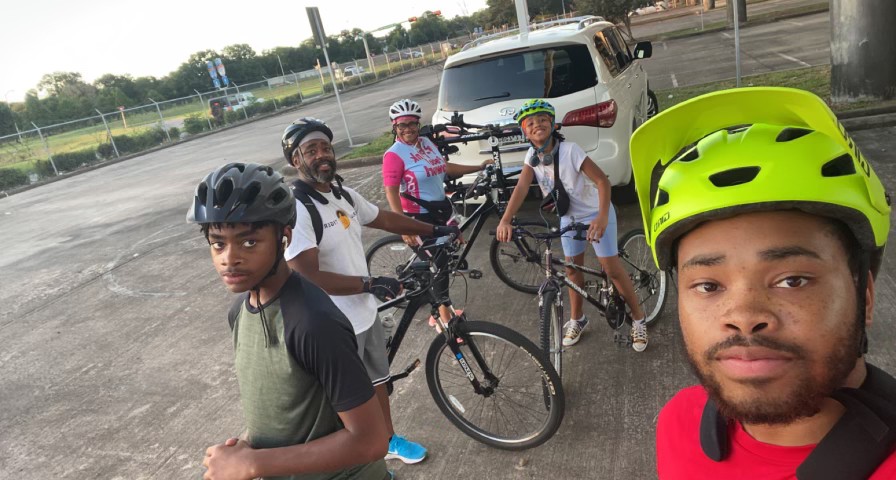As bike and scooter ridership soars, safety challenges grow

Jumping Rocks/UCG/Universal Images Group via Getty Images
Injuries and deaths are also soaring. Observers say helmet mandates are a good place to start.
This story was reported by Youthcast Media Group, which trains high school students from under-resourced communities to report, write and broadcast stories that highlight solutions to the health, wealth and social disparities where they live. Route Fifty will from time to time feature these unique voices and perspectives as they deal with the challenges in front of many state and local governments.
Avir Mitra, a longtime New York City emergency medicine doctor at Mount Sinai Beth Israel in New York City, says on some days at city hospitals, doctors see more patients from bike or scooter collisions than from car crashes.
One particular case stays with him: Emergency medical technicians brought in a young man who had apparently fallen off his electric bike. Doctors thought he was drunk because he was vomiting and his speech was slurred. When Mitra shined a flashlight into the man's eyes, though, his pupils remained dilated—a telltale sign of traumatic brain injury. It turned out the man had flipped over his handlebars and landed on his head in trying to escape a car swerving toward him. A massive hemorrhage had pushed the man’s brain to one side of his skull and into his spinal cord.
“So, his brain had nowhere to go," Mitra said. "Really, probably within an hour he would die.” After emergency surgery and a long hospital stay, the man recovered, although long-term outcomes in such cases are often unclear.
More people are riding bikes and scooters these days. Since the pandemic, trips on shared bikes and scooters have increased steadily in cities across the U.S. and Canada to an all-time high of 157 million trips in 2023, surpassing the pre-pandemic 2019 peak of 147 million trips across both countries.
Micromobility is a buzzword that the U.S. Federal Highway Administration defines as “any small, low-speed, human- or electric-powered transportation device, including bicycles, scooters, electric-assist bicycles, electric scooters (e-scooters), and other small, lightweight, wheeled conveyances.”
One of the reasons for this increase in bike and scooter ridership is that cities have invested heavily in micromobility infrastructure, such as bike lanes, over the past decade. It has made using a bike or scooter more convenient, faster and safer.
Still, with the increase in ridership, there has also been a rise in injuries and deaths: More than 1,100 bicyclists were killed in 2022, up from 976 the year before, according to data recently released by the National Highway Traffic Safety Administration.
Mitra, who is also a professor of emergency medicine and a spokesman for the American College of Emergency Physicians, thinks it’s good to have people out and about as long as they travel safely. But he and other experts want to raise awareness about the growing problem and its solutions.
“When we talk about education, that goes down to everybody understanding the dangers of this,” said Wendy Berk, vice president of the Brain Injury Alliance of New Jersey.
Mitra says even micromobility accidents that don't seem so bad at first can turn out to be serious in the long run. Concussions sometimes result in complications later in life.
“We're finding that people end up getting dementia, people have problems with seizures and people have long-term problems thinking clearly, and cognitive problems in their lives,” he says. “So, even something that we would call a mild brain injury can sometimes be really debilitating and really bad.”
Educating Riders on the Risks
No one understands the risks better than Susan Quick, who is public education coordinator for the Brain Injury Alliance of New Jersey. She gives presentations to schools about the importance of good-fitting helmets, drivers sharing the road and other safety measures.
The topic is a personal one for Quick. In December 1990, her 12-year-old son Brian left his New Jersey home to go on an evening bicycle ride with friends. Around the corner from his home, he took off his helmet. Not long after, Brian was struck by a distracted driver. He was airlifted to a hospital in Camden, where he spent more than three weeks in a coma.

“I still remember for that [first] week, laying my head on his bed praying, 'Please, dear Lord, I don't care if he has deficits, just let him live.' And then thinking to myself, 'Well, what does deficit mean?’” Quick recounted, remembering the doctor’s words to her family. “I considered myself an educated woman. I was an elementary school teacher, but this plunged me into a world I never knew existed.”
Brian defied doctors’ expectations by surviving that first night, then that first week. After six and a half months of rehab, Brian returned home where he received around-the-clock care for the rest of his life. Quick quit her teaching job to facilitate the 24-hour nursing and rehabilitation therapy, which included making their home accessible for Brian, who by then used a wheelchair.
Brian was 37 when he died, in 2015, from complications resulting from his brain injury.
“I think one of my lasting sorrows as we've all grown older now … [is] our family is moving on,” Quick said. “But every time we have a milestone in our family … knowing that Brian is not there, it's a heartache that goes through the rest of your life.”
“If I can make one other family, and one other child, not go through what we went through," she continued, "then it's something positive that has come out.”
Helmets Key to Safety
Quick regularly speaks to school-age children about the importance of helmets, particularly that they are the appropriate size and fit properly. Studies show that properly fitted helmets significantly reduce the risk of head and brain injuries. But helmet use, helmet requirements and enforcement vary widely by state and locality.
“I love when people wear helmets because it's like night and day, and we see it all the time," Mitra said. "When someone hasn't worn a helmet, the problems are infinitely worse.”
Mitra acknowledges that there have been times when he hasn’t worn one.
“I'm just as bad as anybody,” he said. “Men are more likely to get into all these injuries than women, statistically.”
Teens and seniors are the most likely to suffer head injuries.
“We see a peak in teenagers, so like 15-to-19-year-olds, and then people above 65,” Mitra said. For older people, falls are usually the cause. For teenagers, it’s because “younger people … just do dumb things sometimes. And we've all been there, you know?”
More than 20 states require bicycle riders to wear helmets either throughout the entire state or in certain municipalities.
Pam Shadel Fischer, senior director of external engagement for the Governor’s Highway Safety Association, says that helmet mandates are “still so new that I think state legislators don't really understand what [they are]. They don't understand their role and they don't understand that they need to be addressing this, they need to be engaged on this topic,” she said.
Helmet mandates are sometimes discouraged by community organizers. In 2022, Seattle overturned its all-ages helmet law after multiple studies showed police enforced it disproportionately against Black, Native American and unhoused bikers.
Quality bike helmets aren’t cheap, presenting a barrier for those who might rely on micromobility’s convenience and affordability. And many rides are unplanned and “spur of the moment,” said Fischer, who added that helmet sharing-programs have not caught on widely in the U.S. “The providers say they don't have the ability to make helmets available.”
While helmets are helpful, they’re not foolproof. In 2020, three people were killed in New York City in single-vehicle crashes riding mopeds, including a man wearing a helmet who died from severe head trauma. A pedestrian was also struck and killed by a moped that same year.
Medical professionals emphasize injuries to the legs, arms and spinal cord should also be of concern.
Often, the most severe injuries are a result of car collisions. Distracted driving has been cited as a significant factor in injuries and fatalities involving micromobility users and pedestrians; 18% of people killed by distracted drivers in 2021 were not occupants of the vehicles, according to the National Highway Traffic Safety Administration.
“I always tell schoolchildren, ‘If you're in a crash with a car, you're not going to win,’” Quick says. “A bike doesn't win with a car. A scooter doesn't win with a car.”
Can Decision-makers Make Roads Safer for Bikes?
Many experts and advocates hope infrastructure plays a role in preventing more injuries and deaths. Fischer points to the Netherlands as an example of effectively integrating micromobility into city planning. Protests in the 1970s against the high rate of children killed by car collisions are credited with transforming the streets of Dutch cities to be less car-dependent. Today, the country is known for its biking culture and infrastructure that encourages multiple forms of transportation. Helmets are not commonly worn.
“And because it is so much a part of the transportation system, car drivers know to be on the lookout for bicyclists, so they slow down, they know how to share the road,” Fischer said.
Still, some micromobility users question the likelihood of similar changes in most U.S. cities and towns.
Johnathan Kimble, 24, is a regular biker and user of electric scooters who worked for six years at Houston Cycling Centers in Texas. “To an extent, I think a lot of American cities aren't built to have the infrastructure to transfer just to biking or to micromobility, because it's too big,” he said. He likes the protected bike lanes he’s observed in some cities, with barriers such as curbs, flexible bollards and wheel stops.

“If your car tries to drive over [the curb], you’re going to tear up your car before you tear up a bicyclist,” Kimble said. “But it also almost adds another second of reaction time for either the car or the cyclist—instead of just boom, you're there and it's done.”
Overall, local governments should be doing more to increase bike lanes and barriers around them, he says, and driver’s education programs should put more emphasis on pedestrians and micromobility.
Multiple cities and states have adopted Vision Zero, a campaign to eliminate traffic injuries and deaths. Experts say more research and data is needed to determine the prevalence of fatalities and injuries on e-bikes and e-scooters and to address other areas of micromobility in the future.
“It needs our policymakers, it needs advocates, it needs the general public to be aware, it needs all of us doing our part,” Quick said.
For many, it comes down to awareness and consideration for everyone on the road. Safety is a shared responsibility, experts emphasize.
“So, one of our big messages to people who are roadway users, who are driving, is to share the road with other vulnerable roadway users," Quick said. "And that would include your bicyclists, motorcyclists, pedestrians, people who may be in wheelchairs on the side of the road, or scooters. Anybody who is not in a car.”
Kyndall Hubbard is a former Youthcast Media Group assistant editor. Radiah Jamil is a YMG alum and former intern and is a rising junior at St. John’s University in Queens, New York. YMG mentor-editor and former USA Today reporter Erik Brady contributed to this story.
NEXT STORY: The key to safer roads? Narrow the lanes.





